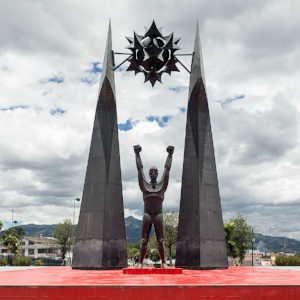Recently, the volunteers of Manna Project Ecuador, including myself, took a day trip to a giant dormant volcano called Quilotoa. Quilotoa had been on our list of places to visit since we arrived in Ecuador, and we were very excited to finally see it. Quilotoa was created by a massive eruption about 800 years ago and is now a crater filled with water about two miles in diameter. We left the volunteer house at 6 am to get to Quilotoa as early as possible. The bus ended up taking 5 hours- longer than any of us had expected- but It was well worth the trip. Since traveling in the Andes provides incredible mountainous landscapes, the bus seemed to go faster than it was and the views were really amazing. Finally, we arrived to the crater lake!
Upon seeing the massive lagoon inside the ancient volcano, we were all dumbstruck. It was like nothing any of us had ever seen before. After we regained our composure, we began the trek down into the volcano to the shore of the lagoon. The hike down took us about an hour, and dogs that seemed to live in Quilotoa followed us the whole way down. Once we reached the bottom, we explored the shore line and took many photographs of the amazing landscape around us. To climb back out of Quilotoa, we quickly realized that the almost 1,000 ft climb up would be much harder than the descent. Because of the hike, a few of us decided to ride on mules to the top, which turned out to be quite the hilarious experience! We then had lunch and headed back to Valle De Los Chillos- our home. We arrived at the volunteer house around 9 pm that night, utterly exhausted, but feeling as if we could not have spent the day in any better way!
To travel to incredible places like Quilotoa, apply to be a Program Director with the Ecuador site today!


















